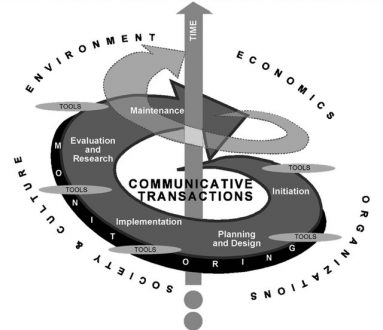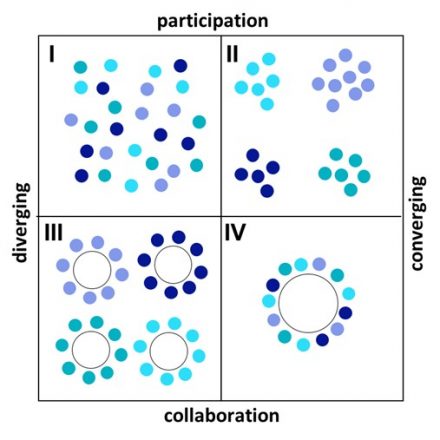
Pick a Method From Tool-KIT
Step 3: Choose a Suitable Participation Method
Use the Tool-KIT of participation methods to choose a method which suits you most. The choice of participation method depends on the following criteria:
-
Number of participants
How many people do you want to involve? Do you want to discuss the prospective project in a small group or the general public?
-
Geographical & thematic scope
The number and profile prospective stakeholders depend on the scale of the planning document.
-
The planning phase
Planning can be conceptualised a process, which unfolds in certain stages. Each stage has its own goals, methods, and results.
-
The level of stakeholder engagement
Classification of participation exercises according to the share of public authority in planning decisions
-
Spectrum of Public participation
Classification of participation exercises according to the share of public authority in planning decisions
-
The mode of communication
Take a pick between traditional face-to-face methods or modern online tools
-
Type of methods
Choose between Expressive , Diagnostic, Organisational, and Political tools
-
Skills and resources required
What skills and resources are required of the participants and you
-
Knowledge needs and the mode of working
Do you want to diverge or converge your knowledge? Furthermore, do you want to encourage participation or collaboration
The anticipated number of participants
How many people do you want to involve? Do you want to discuss the prospective project in a small group of experts? Or, do you want to acknowledge the needs and wants of the general public? Discussions in small groups will give you a rich and multifaceted understanding of the issue in focus, e.g. the rationale for certain opinions or positions held by the stakeholders. The methods for small groups, 1-5 or 5-30, usually rely on the qualitative research techniques. Acknowledging the opinions of the general public will indicate what share of the general public holds certain opinions and positions. The methods for bigger groups, 31+, usually rely on quantitative techniques. The combination of information collected in small and big groups will enrich your understanding of the project related issues.
The geographical scale (and thematic scope) of a plan
How big is the area in focus of a plan? The scale and thematic scope of a plan will define the number and profile of prospective stakeholders. If you are designing a public space, you might want to engage individual stakeholders, such as current and prospective users of the public space. If you are drawing a regional development plan, you might want to involve institutionalised stakeholders, such as environmental or professional NGO’s.
The planning phase
Planning can be conceptualised a process, which unfolds in certain stages. Each stage has its own goals, methods and results. In the Initiation phase either community, or local government, or communities jointly with the local government initiate change in the urban environment. Initiation phase includes the preliminary research of the current state of affairs (e.g. of the site conditions, of stakeholders’ opinions, etc.), which concludes with a problem statement. In the Planning and Design phase the agenda of the project is developed and key (design) decisions are taken. In this phase the community chooses the format of further involvement or it may chose to refrain form further participation. Participation in the Implementation phase is dependent on the scale and nature of the project. Small projects, such as a children’s playground or community garden, may be fully implemented by the community. Larger projects, demanding heavy machinery, are usually implemented by the local authority.

Figure 2. Iterative cyclical planning process. Source: Horelli (2002)
The same is relevant for the Maintenance phase, where communities may be responsible for the maintenance of small local public spaces, and local authorities – for the maintenance of the large and city-wide services and infrastructure. Evaluation & Research phase is often either excluded from the planning process, or is conducted superficially. However, this phase is essential to reflect on the planning and participatory process and outcomes, to identify successes and failures, and devise the guidelines for improvements. Planning phases are often conceptualised as an iterative cyclical process, where where the end of the previous planning cycle lays the foundation for the next planning cycle (Figure 2).
The level of stakeholder engagement
The International Association for Public Participation (2018) has developed a Spectrum of Public Participation (based on the Ladder of Public Participation developed by Arnstein in 1969) classifying participation exercises into categories depending on the share of public authority in planning decisions, starting from being informed about planning decisions (“inform”) and culminating in taking planning decisions (“empowerment”). The detailed description of the degrees of public participation is provided in the Figure 3.

Inform
Inform

Consult

Involve
Involve

Collaborate
Collaborate

Empower
The mode of communication
How would you like to communicate with the stakeholders, online or face-to-face? In recent decades online participation methods, through social media groups, applications for portable devises, websites, etc. is gaining popularity. The benefits of online participation include the ability to participate anytime and from anywhere. Additionally, some online participation tools include algorithms which analyse user feedback and summarise it in the form of coherent diagrams. Despite the ubiquitous use of online technologies and growing digital literacy, face-to-face participation methods are still important, especilally, for the purposes of building trust between stakeholders, developing interest and spatial communities, as well as for reaching consensual decisions. Some contemporary patricipation methods combine state-of-the-art digital technologies with face-to-face meetings, for instance a decision theatre which takes advantage of immersive visualisation environment.
Type of methods
Engagement methods can be classifies into expressive, diagnostic, organisational and political depending on their purpose. Expressive tools boost creativity and facilitate communication of ideas through an array of audiovisual techniques, such as drawing, modelling, role-play, etc. Diagnostic tools evaluate personal, environmental, and situational variables, Organisational tools support the implementation of outcomes of participatory exercises in real-life, while Political tools shape agendas and help setting priorities.
Skills and resources required
Each participatory tool demands a certain amount of skills from participants and resources from the organisers. Some tools do not demand any effort or planning specific competences from the part of participants, such as Observation. Other tools, such as Future workshop, yield better results, if participants have good team work skills and some knowledge about the issues in focus. Some tools, like Walkthroughs, require a relatively short preparation time and investment. Other tools, such as (Serious) Game, may take up to one year to develop and substantial human and monetary investments. The choice of the tool is very much affected by the amount of resources available.
Knowledge needs and the mode of working
Contemporary planning theory conceptualises spatial planning as communication between the stakeholders, which enables mutual learning. These communications may be divided into four categories, depending on the knowledge needs and the mode of working, and represented as a Fourfold classification of communicative actions. Figure 4 represent the fourfold model of communicative actions graphically. In short, divergence refers to the process of opening up to multiple voices and perspectives, when creating new knowledge and ideas, whereas convergence refers to closing down, when assessing the value of generated knowledge and ideas. The distinction between working in big and small groups is made to emphasise the difference in communication opportunities between the stakeholders within the big and small group. While drawing a Public participation plan (PPP) try to use at tools and methods from all four categories.
I Broad public produce diverse information or ideas for planning.
The goal is to get as many individuals as possible to give their knowledge input to the process. The output comprises of a large variety of data, information, knowledge and ideas as a foundation for further phases.
II Knowledge is converged (structured, organized) with the broad public.
The goal is to recognise what kind of support different ideas or knowledge claims get from people. The output includes valued knowledge claims or selected ideas (one or more) for further elaboration.
III Working together to make an input to the process.
The goal is to get knowledge and ideas from diverse groups to be elaborated further in the process. The output contains a variety of different approaches and ideas as a foundation for further phases.
IV Knowledge is converged in a smaller group.
The goal is to integrate and further develop planning knowledge and ideas in a collaborative manner. The output is a shared understanding of the direction and contents of the related planning process.




